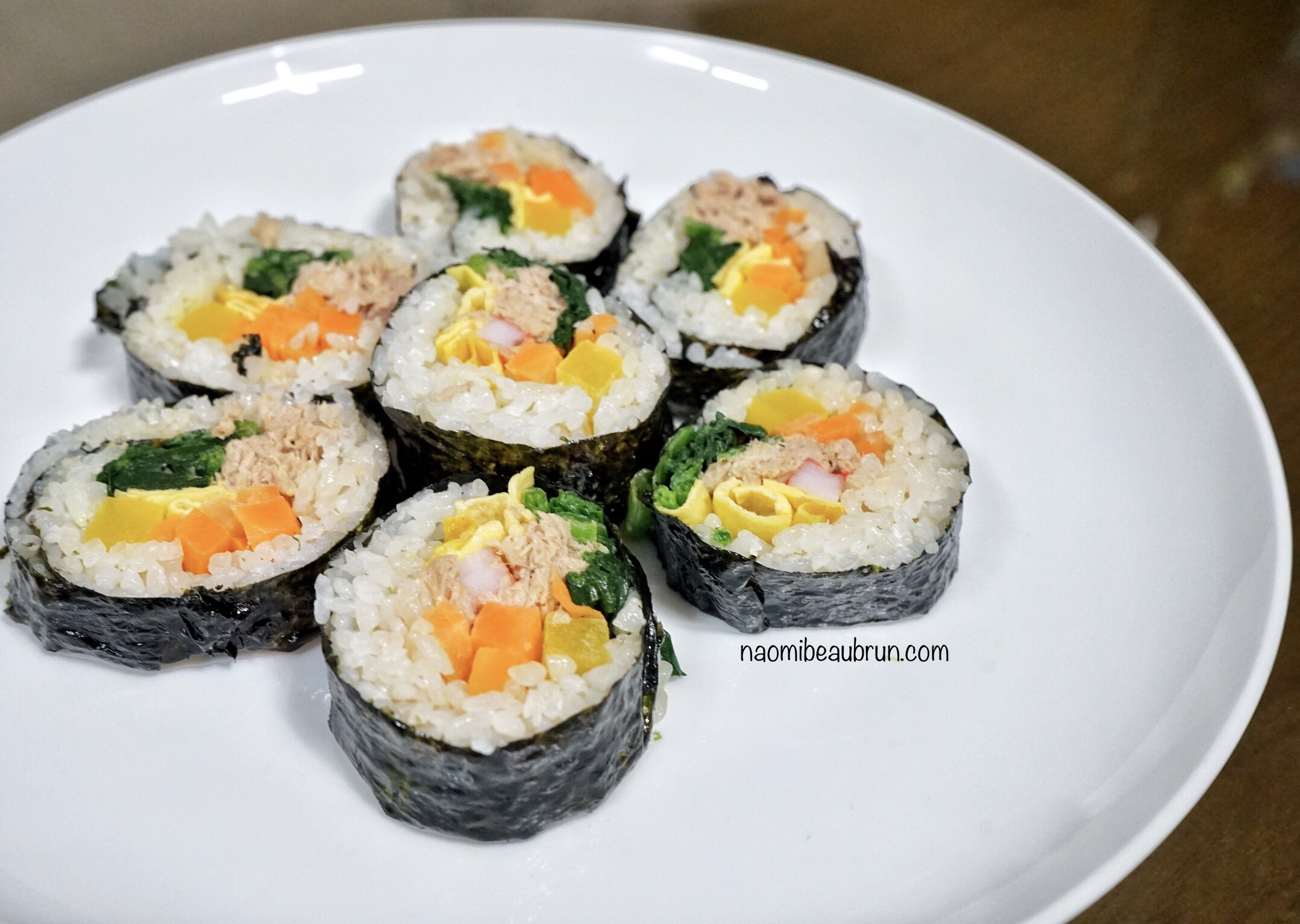Making Kimbap (Gimbap) For The First Time!

Making kimbap (gimbap) 김밥 or seaweed rice rolls is truly an art. This popular Korean snack is one of my all time favorites.
I finally decided to make this dish for myself after countless trips to the CU, a convenient store, to purchase kimbaps there. They cost about 2,000 won (~ approx. less than $2).
This snacks literally translates to seaweed rice. Kim 김 seaweed and bap 김밥 rice. The seaweed wraps around the rice, vegetables, meat filling or other ingredients. It’s the perfect finger food snack to bring on a picnic or to a party.
I chose to make a tuna kimbap but you can use which ever meat you’d like. Beef 불고기 (bulgogi) or chicken 닭 (dalg) is commonly used. Meatless kimbap tastes just as good.
I thought making kimbap was going to be easy. Shh don’t tell anyone but it took me almost two hours to make. On average, it definitely shouldn’t take this long. Prepping some ingredients the night before can help cut the cooking time down.
Ingredients:
- 4 roasted seaweed sheets
- 2 cups rice
- 3 eggs
- 8 ounces spinach
- 2 teaspoons sesame oil
- 2 garlic cloves
- 1/2 teaspoon of salt
- 4 pre cut yellow pickled radish strips
- one medium carrot (chop thinly into sticks)
- 2 precut imitation crab meat strips (optional)
- 200 g can of tuna
- 2 tablespoon mayonnaise
- black pepper
Equipment
- Kimbap bamboo mat

Let’s Cook
Have separate plates or a large platter ready to set each cooked ingredient.
1. Rice – Start by making 2 cups of rice. I use a rice cooker so this way the rice will be cooking while I prepare the other ingredients.
2. Spinach – To prepare the spinach, wash the bunch then blanch in boiling water for 1 minute. After rinsing off spinach with cool water, gently squeeze excess water. In a bowl add 2 teaspoons of sesame oil, 1/2 teaspoon of salt, 2 cloves of minced garlic then mix together by hand.
3. Carrots – Wash, finely chop your carrots. Sauté in a heated pan with oil for about 2 minutes.
4. Canned Tuna – To prepare the tuna, open the can and drain the excess water. Add 2 tablespoons of mayonnaise, a few dashes of black pepper then mix together.
5. Eggs – Make one egg at a time. Beat one egg in a bowl. Heat up your pan and add oil. It would be great to use a nonstick pan. When the pan is hot enough, pour your egg mixture. Spread the eggs around the pan, to create an even, flat circle in the pan. When it’s completely cooked at the bottom (ideally it should be a yellow color; avoid over frying) flip your egg and turn off the heat. Let’s the other side cook briefly. After it’s made, cut the eggs into 1/2 inch wide strips.
Let’s Stack and Roll

Now that’s all the ingredients are cooked it’s time to neatly stack them together on the seaweed sheets and roll.
Take one sheet of seaweed and place it on the bamboo mat. Be sure to set your ingredients parallel to the horizontal lines of the bamboo mat. (Refer to the picture above) I had to slowly lift and turn the seaweed sheet with everything on it in the right direction to roll the kimbap.
Start with rice. Take 1/2 a cup of rice and spread evenly cross the seaweed sheet. Leave 2 inches on the end for rolling purpose. Put the tuna, spinach, yellow pickled radish, eggs, imitation crab meat, and carrot in the center of the sheet.
Use both hands to roll. Gently tighten your grip on each roll, to keep the ingredients intact. Push out the mat as you roll to keep it from getting stuck. When the roll is complete, set it aside then add some sesame oil on top. Cut the kimbap into 1/4 inch sizes with sharp knife. Wipe down the knife after each cut for a smoother experience.
You’re ready to plate and serve!

Making this kimbap was a labour of love. A few things I struggled with were:
- Adding the right amount of rice on the seaweed sheet and spreading it across evenly so it has that perfect symmetrical look after it’s rolled.
- Preventing the seaweed sheet from tearing while cutting it into pieces. It seemed to be a little bit too damp on the mat when it came time to cut.
One thing I also noticed was the kimbap started breaking apart before the knife completely cut through. Recently, a Korean teacher at my school gave me some insight. She suggested I should add oil to the knife so it cuts more smoothly. I’m more than ready to try this recipe again. Happy eating!
Related Posts
Strawberry Jam – Ttalgi Jam 딸기잼
Tis the season to make strawberry jam! Strawberries are finally in season in Korea. In…
December 30, 2020Spicy Korean Chicken Stew – Dak Bokkeum Tang 닭볶음탕
Let me be the first to warn you: you may be tempted to scrape off…
November 20, 2020


Leave A Comment